Mastering Sous Vide Miso Salmon: A Flavorful & Effortless Japanese-Inspired Delight
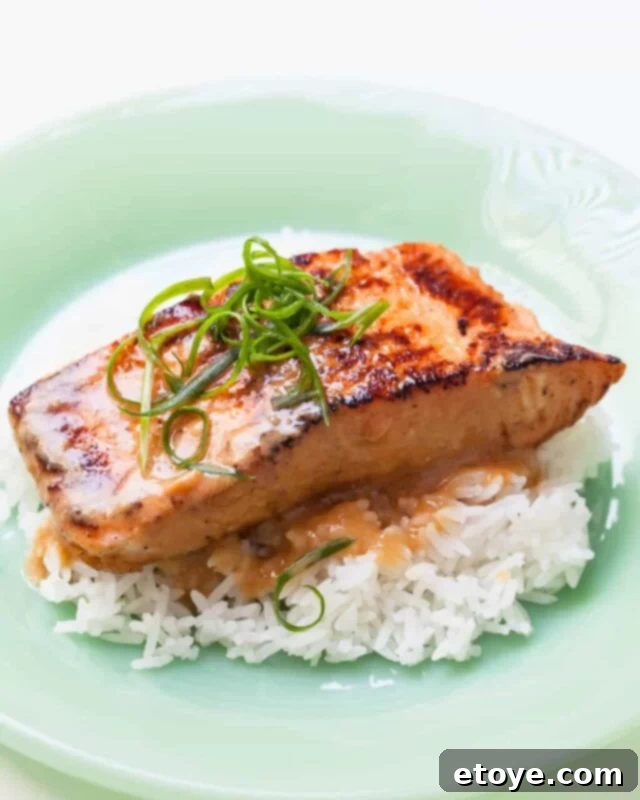
Embark on a culinary journey with this incredible Sous Vide Miso Salmon recipe. This dish combines the rich, umami flavors of traditional Japanese cuisine with the precision and ease of sous vide cooking, resulting in a salmon fillet that’s perfectly cooked, flaky, and bursting with a sweet and savory glaze. If you’re looking for an effortless yet elegant meal that truly impresses, look no further. With just a handful of simple ingredients and minimal hands-on time, you can create a restaurant-quality salmon dish right in your own kitchen.
Our recipe is designed to be incredibly approachable, even for those new to sous vide. It requires only 5 core ingredients and about 5 minutes of active preparation. The magic of sous vide takes care of the rest, ensuring your salmon is cooked to perfection every single time. Miso-marinated salmon offers a versatile and full-flavored experience that pairs beautifully with a variety of sides, from fluffy steamed rice and nutritious quinoa to creamy mashed potatoes or a vibrant salad. The secret lies in the simple yet profound marinade and sauce, crafted from three essential Japanese ingredients readily available in most major supermarkets: Miso, Mirin, and Saké.
Why Sous Vide Salmon is a Game Changer
Sous vide cooking, meaning “under vacuum” in French, involves cooking food in a precisely temperature-controlled water bath. While it might sound complex, it’s actually one of the simplest and most foolproof methods for cooking delicate proteins like fish. Here’s why sous vide is the ideal technique for our Miso Salmon:
- Unparalleled Consistency: Say goodbye to overcooked, dry salmon. Sous vide ensures your fish reaches the exact desired internal temperature from edge to edge, resulting in an incredibly moist and flaky texture every single time.
- Perfect Texture: The gentle, even heat of the water bath prevents the outer edges of the salmon from cooking faster than the center, eliminating the “done on the outside, raw on the inside” dilemma. You get perfectly tender and succulent salmon throughout.
- Deep Flavor Infusion: By cooking the salmon in a sealed bag with its miso marinade, all the wonderful flavors are locked in and deeply infused into the fish. The marinade works its magic without being diluted by cooking liquids.
- Hands-Off Cooking: Once the salmon is in the water bath, your work is largely done. This frees you up to prepare side dishes, set the table, or simply relax, making it perfect for busy weeknights or entertaining.
- Superior Sear: Sous vide cooks the salmon gently, leaving it ready for a quick sear at the end. This final step creates a beautifully caramelized, crispy crust without compromising the perfectly cooked interior.
Understanding Our Key Japanese Ingredients
The heart of this Miso Salmon recipe lies in its incredibly flavorful marinade, built upon three pillars of Japanese cuisine:
- Miso Paste (Shiro Miso): Miso is a traditional Japanese seasoning produced by fermenting soybeans with salt and kōji (a fungus) and often rice, barley, or other ingredients. For this recipe, we specifically use Shiro (white) miso. Shiro miso is lighter in color and has a milder, sweeter flavor profile compared to darker, more intensely flavored red miso varieties. It imparts a delicate umami richness and a subtle sweetness that beautifully complements the salmon without overpowering it. Miso is also packed with probiotics, adding a healthy boost to your meal.
- Mirin (Japanese Sweet Cooking Wine): Mirin is a type of rice wine similar to saké, but with a lower alcohol content and a significantly higher sugar content. It’s a fundamental ingredient in Japanese cooking, used to add a touch of sweetness, a glossy sheen, and to help flavors penetrate food more effectively. Its mild acidity also helps tenderize the fish.
- Japanese Saké (Cooking Sake): Saké, or Japanese rice wine, plays a crucial role in marinades. It helps to tenderize proteins, remove any fishy odors, and carries flavors deep into the food. Cooking saké is generally used, which is a less refined version specifically for culinary purposes. Together, miso, mirin, and saké create a balanced, complex, and incredibly delicious marinade that makes this salmon truly special.
Selecting the Perfect Salmon Fillet
The quality of your salmon can significantly impact the final dish. Here are a few tips for choosing the best fillets:
- Freshness is Key: Look for salmon with bright, moist flesh and no discoloration. It should have a clean, fresh smell, not overtly fishy.
- Thickness Matters: This recipe is optimized for salmon fillets approximately 1.25 inches thick. If your fillets are significantly thicker (e.g., 1.5-2 inches), you may need to increase the sous vide cooking time to 45 minutes to ensure they cook through evenly. Thinner fillets will cook faster, so adjust accordingly.
- Skin-On or Skin-Off: While either works, skin-on salmon provides an extra layer of protection during sous vide cooking and can be crisped up beautifully during the final sear, adding texture and flavor.
- Type of Salmon: Varieties like Atlantic salmon (often farm-raised), King (Chinook), Sockeye, or Coho salmon (often wild-caught) all work wonderfully. Choose based on your preference for flavor, fat content, and availability.
Step-by-Step Guide to Perfect Sous Vide Miso Salmon
Creating this gourmet dish is simpler than you might imagine. Follow these detailed steps for a truly exceptional result.
1. Prepare Your Exquisite Miso Marinade
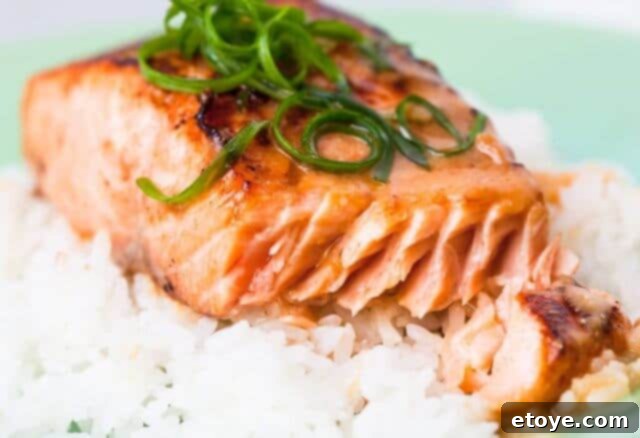
In a medium-sized bowl, combine the shiro (white) miso paste, Japanese saké, and mirin (Japanese sweet cooking wine). Use a whisk to vigorously blend these ingredients. Continue whisking until the mixture transforms into a perfectly smooth and uniform paste. This ensures that the marinade will evenly coat your salmon, infusing every bite with its complex flavors.
2. Achieve a Silky-Smooth Consistency

As you whisk, you’ll notice the distinct textures of the miso, sake, and mirin starting to meld. Keep going until there are no lumps of miso left and you have a luscious, smooth marinade. This consistency is crucial for both flavor distribution and aesthetic appeal.
3. Marinate the Salmon Fillets

Carefully take your prepared miso mixture and generously spread it over all surfaces of each salmon fillet. Ensure every part of the fish is covered. The rich marinade will begin its work, tenderizing the salmon and imparting its signature umami flavor even before cooking begins. This step is key to a truly flavorful final product.
4. Prepare for the Sous Vide Bath
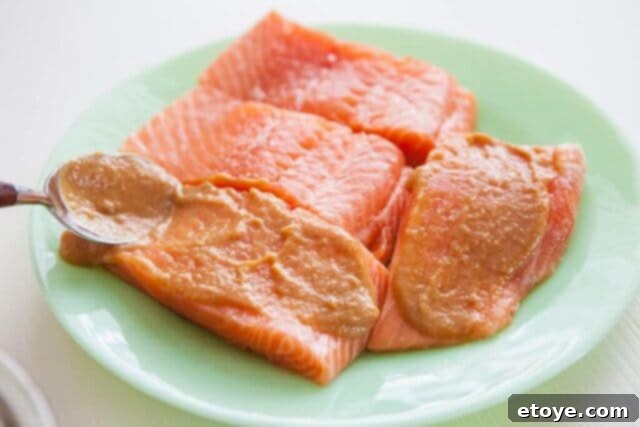
Once marinated, carefully place each salmon fillet into a gallon-sized freezer bag. Along with the salmon, add a couple of small pats of butter into the bag. The butter will melt during cooking, adding richness and helping to create an even more luxurious texture. Be mindful not to add too much; just a little is sufficient to enhance the flavor without making it greasy.
5. The Gentle Water Displacement Method

When cooking delicate items like seafood, using a traditional vacuum sealer can sometimes be too aggressive. The powerful suction can easily damage the delicate flesh of the fish, making it misshapen or compromising its texture during cooking. Instead, we highly recommend the water displacement method.
To do this, slowly submerge the bag containing your salmon into the water bath, leaving just the very top edge of the bag (where the seal will be) above the water line. The pressure of the water will naturally push the air out of the bag.
6. Secure the Bag
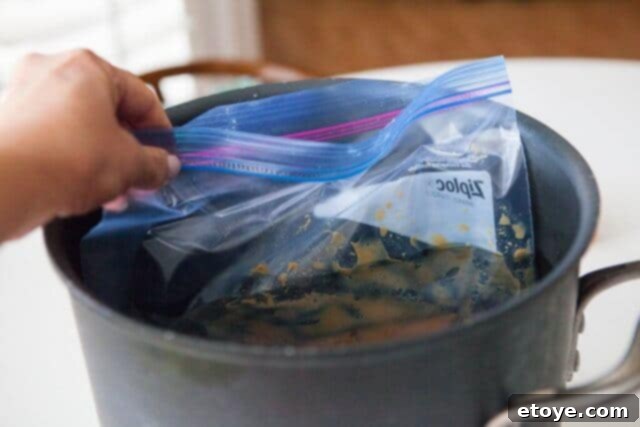
Once most of the air has been displaced by the water, carefully seal the bag completely shut. This method creates a vacuum seal that is gentle enough for delicate fish while being perfectly effective for sous vide cooking. Ensure the seal is tight to prevent any water from entering the bag during cooking.
7. Position for Cooking

After sealing, clip the bag to the edge of your pot or container. This prevents the bag from floating and ensures that the salmon remains fully submerged in the water bath throughout the cooking process, guaranteeing even heat distribution and consistent cooking.
8. Sous Vide Cooking Time and Temperature

Set your sous vide immersion circulator to 104°F (40°C). This temperature yields an incredibly tender, medium-rare to medium texture that is moist and flaky without being raw. Allow the salmon to cook in the water bath for 30 minutes once the water reaches the set temperature. For thicker fillets (over 1.5 inches), you might extend the cooking time to 45 minutes. For those who prefer a more cooked salmon, a temperature of 120°F (49°C) can be used, but this 104°F setting truly showcases the delicate nature of the fish.
9. Post-Sous Vide Preparation
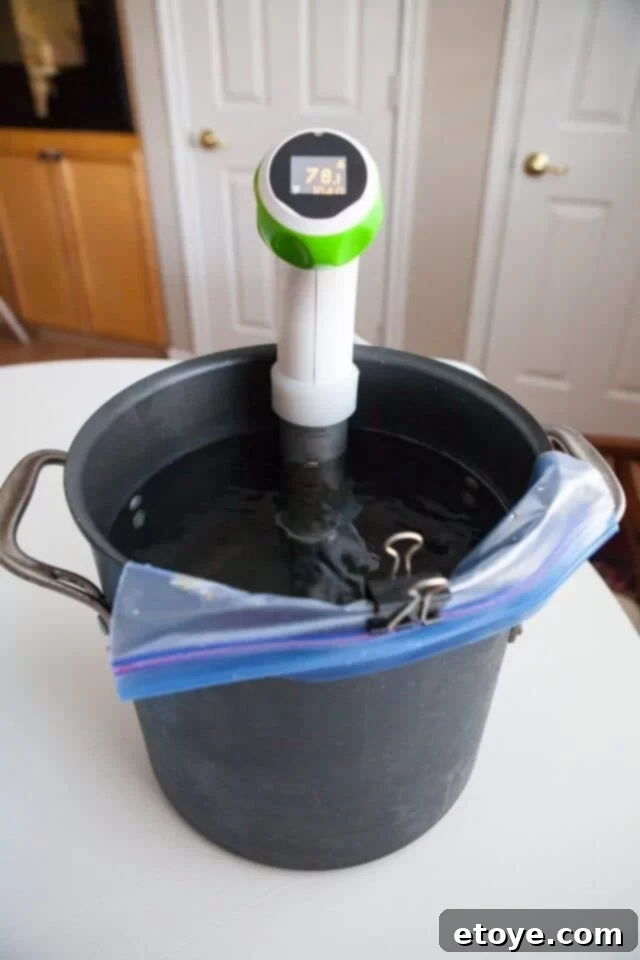
Once the sous vide cooking time is complete, carefully remove the salmon fillets from the bag. Be extremely gentle as the fish will be very delicate and could break apart easily. Pour the remaining miso sauce from the bag into a small bowl and reserve it for later. This sauce, now enriched with salmon juices, will be transformed into a delectable glaze. Next, pat the salmon fillets thoroughly with a paper towel, wiping off any excess miso marinade. This step is critical; if you don’t remove some of the miso, it will burn quickly in the hot pan during searing, leading to an unpleasant bitter taste and charred bits.
10. The Perfect Sear
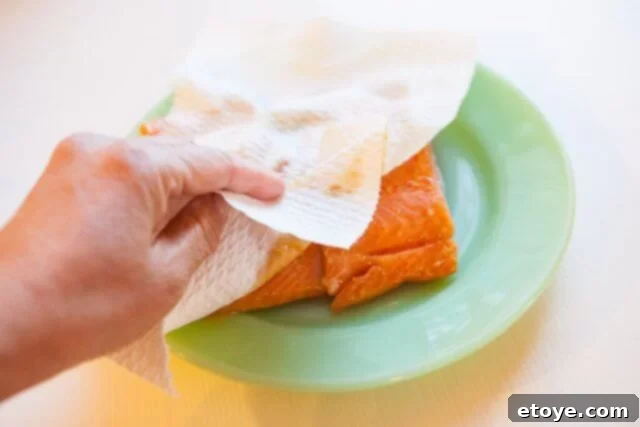
Heat a frying pan over medium-high heat. Add a tablespoon of cooking oil with a high smoke point, such as avocado oil or grapeseed oil. Once the oil is shimmering and hot (but not smoking), carefully place the salmon fillets, skin-side down if applicable, into the pan. Sear each side for approximately 1 minute. The goal here is to create a beautiful, golden-brown crust and enhance the flavor without overcooking the perfectly tender interior. The quick high heat will also crisp up the skin beautifully.
11. Final Glaze and Presentation
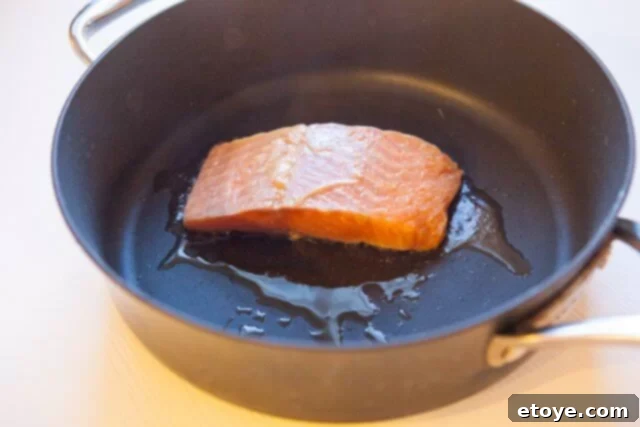
After searing, remove the salmon to your serving plates. Reduce the heat under the frying pan to low. Pour the reserved miso butter sauce into the pan and cook for about 30 seconds, stirring gently, to allow it to thicken slightly into a rich glaze. Spoon this exquisite sauce generously over your beautifully seared salmon fillets. For a final touch of freshness and visual appeal, garnish with thinly sliced green onions or a sprinkle of toasted sesame seeds. Serve immediately and savor every bite.
Recipe: Sous Vide Miso Salmon
This recipe ensures perfectly cooked, flavorful salmon every time. It’s designed for fish pieces about 1.25″ thick. If you are using thicker pieces of fish (e.g., 1.5-2″), increase the sous vide cooking time to 45 minutes. You can adapt this method for other delicate fish like cod or halibut.
Prep Time: 5 mins
Sous Vide Cook Time: 30 mins
Total Active Time: ~10 mins
Servings: 4
Ingredients
- 2 tablespoons shiro (white) miso paste
- 2 tablespoons Japanese sake
- 2 tablespoons mirin (Japanese sweet cooking wine)
- 2 tablespoons unsalted butter, divided into small pats
- 4 salmon fillets (about 5 ounces each, 1.25″ thick)
- 1 tablespoon high-smoke-point cooking oil (e.g., avocado, grapeseed)
- 1 green onion, very thinly sliced, or sesame seeds (optional, for garnish)
Instructions
- In a medium bowl, whisk together the miso paste, Japanese sake, and mirin until a smooth paste forms.
- Generously spread the miso mixture over each salmon fillet, ensuring all surfaces are coated.
- Place the marinated salmon fillets into a gallon-sized freezer bag. Add the pats of butter to the bag alongside the salmon.
- Set your sous vide immersion circulator to 104°F (40°C). Once the water bath reaches the target temperature, carefully submerge the bag, using the water displacement method to remove air, and seal it tightly. Clip the bag to the side of the pot to keep it submerged.
- Cook for 30 minutes. If using thicker salmon fillets (over 1.5 inches), cook for 45 minutes.
- When the salmon is done cooking, carefully remove the fillets from the bag (they will be delicate). Pour the remaining miso butter mixture from the bag into a small bowl and reserve it.
- Gently pat the salmon pieces dry with paper towels to remove any excess moisture and miso marinade from the surface. This prevents burning during searing.
- Heat a frying pan over medium-high heat. When hot, add the cooking oil and swirl to coat the pan.
- Carefully place the salmon fillets into the hot pan and sear each side for approximately 1 minute, or until a beautiful golden-brown crust forms. Remove the salmon to a serving plate.
- Reduce the heat under the frying pan to low. Pour the reserved miso butter sauce into the pan and cook for about 30 seconds, stirring constantly, to slightly thicken it into a glaze.
- Spoon the thickened miso glaze over the seared salmon fillets. Garnish with thinly sliced green onions or a sprinkle of sesame seeds, if desired. Serve immediately.
Tips for Success
- Don’t Over-Marinate: While miso is a mild marinade, marinating fish for too long (e.g., more than 2-4 hours) can sometimes cure it or change its texture excessively. 30 minutes to an hour is usually sufficient for deep flavor.
- Pat Dry Thoroughly: The key to a good sear is a dry surface. Don’t skip wiping off the excess miso and moisture from the salmon before it hits the hot pan.
- Hot Pan, Quick Sear: Ensure your pan is very hot before adding the salmon. This allows for a quick sear that creates a crust without overcooking the delicate interior.
- Adjust Temperature to Preference: While 104°F (40°C) offers a wonderfully tender, almost medium-rare experience, feel free to adjust. 110°F (43°C) for medium-rare plus, or 120°F (49°C) for a firmer, medium texture.
- Experiment with Miso: While shiro miso is recommended for its sweetness, a blend of shiro and awase (mixed) miso can also provide a deeper, more complex flavor.
Delicious Variations & Serving Suggestions
This Sous Vide Miso Salmon is incredibly versatile. Here are some ideas to customize it or enhance your meal:
- Ginger & Garlic Infusion: Add a teaspoon of grated fresh ginger and a minced garlic clove to the miso marinade for an extra aromatic kick.
- Spicy Miso: Stir in a pinch of red chili flakes or a small amount of sriracha to the marinade for a subtle heat.
- Citrus Brightness: A squeeze of fresh lime or lemon juice over the finished salmon or a tiny amount of zest in the marinade can add a refreshing counterpoint to the rich miso.
- Different Fish: This same technique and marinade work beautifully with other firm, flaky white fish like cod, halibut, or even black cod (sablefish).
- Pairing Perfection:
- Rice & Veggies: Serve with steamed jasmine or brown rice and a side of quick-sauteed bok choy, asparagus, or roasted broccoli.
- Noodle Bowls: Flake the salmon over a bowl of soba or udon noodles tossed with a light dressing.
- Salad Topper: A fantastic addition to a vibrant green salad, perhaps with an Asian-inspired vinaigrette.
- Mashed Potatoes: For a comforting meal, serve atop a bed of creamy mashed potatoes or even a cauliflower puree.
Storage and Reheating
Leftover Sous Vide Miso Salmon, if stored properly, makes for a delicious meal the next day. Place any leftover salmon and reserved sauce in an airtight container in the refrigerator for up to 2-3 days.
To reheat, gently warm the salmon in a pan over low heat until just heated through, being careful not to overcook it. The microwave can also be used, but warm in short bursts to maintain moisture. The reserved sauce can be gently reheated and drizzled over the salmon.
Indulge in the simplicity and sophistication of this Sous Vide Miso Salmon. It’s a testament to how precise cooking methods combined with classic flavors can elevate an everyday ingredient into an extraordinary culinary experience. Enjoy the journey of creating this delicious, healthy, and utterly satisfying meal!
